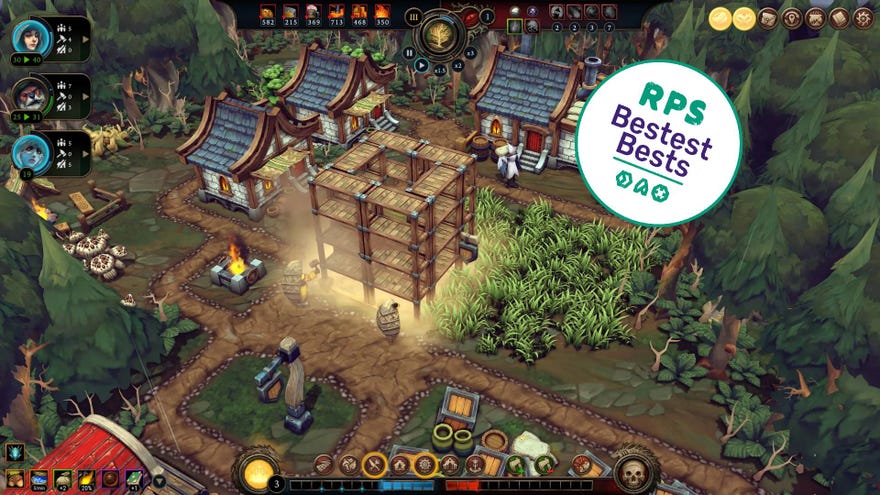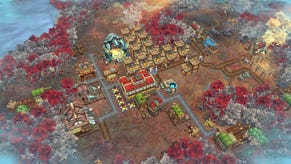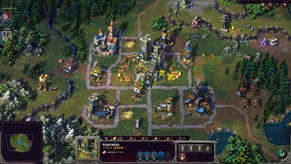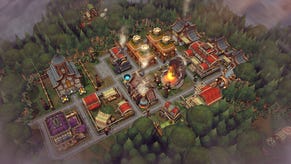Against The Storm review: a roguelite citybuilder awash with great ideas
Let the weather get you down
Following two years in early access, roguelite citybuilder Against The Storm has finally reached its 1.0 milestone. It’s a combination of genres that seem to pair together as naturally as sausages and strawberry jam. Don’t get me wrong, I’m a fan of both of these things as separate entities, but together? My assumption was that they would prove too strange to stomach, but much like the cursed pork and berry snack that became a staple of my university diet, the result is a thrilling concoction that delights the palette. I’ll say it right up top: Against The Storm is one of this year’s best.
As the Queen’s Viceroy, it’s your job to establish villages in an endless forest that surrounds the Smouldering City, civilisation’s last remaining bastion after a cataclysmic event known as the Blightstorm destroyed the world. This dense wilderness is fraught with danger, a corruption that whispers through the trees and fractures the resolve of those that linger within its shaded glades.
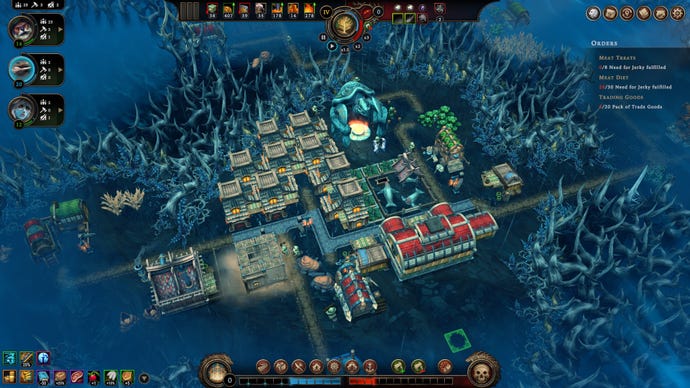
Unlike most citybuilders, the aim of Against The Storm is to push through the wilderness a settlement at a time, selecting a node from a world map before beginning construction within a procedurally generated patch of trees. Once a handful of hamlets have been successfully managed, the blightstorm returns, washes them away and twists the forest's overworld map into a different layout. As an economy-based citybuilder, you'll create production lines that transform resources gathered from the surrounding forest into more complex items that can then be consumed or sold. Think The Settlers, before Ubisoft decided it needed lads with swords on the cover to appeal more to teenagers.
There is no combat here, though. Instead of vikings or (shudder) the English, your main antagonists are abstract concepts. Hunger. A sustainable source of fuel. A raging storm that arrives in phases, the harshest of which reduces your citizen’s happiness substantially. Fail to feed them nice biscuits or slices of pie, and there’s a chance your entire workforce will wander off back home.
But it’s the Queen herself who lives to give you the most grief. Specifically her impatience, an emotion so pervasive that it has its own dedicated bar at the bottom of the screen that steadily increases the longer it takes you to complete your miniature city. If it reaches the top, you fail, and it’s time to retreat back to the Smouldering City, lizard or fox tail between your legs. Success, meanwhile, is achieved by increasing your reputation, points that are rewarded for ensuring your citizens are kept happy, tasks are completed and the forest’s persistent corruption is kept at bay. Earn enough and your settlement is deemed complete, allowing you to move onto the next.

But ah! Remember! Against The Storm is also a roguelite, meaning everything, from the citizens who embark on your journey with you (a mix of humans, lizards, beavers and - later - harpies and foxes, too), the resources available within your current map and even the buildings you are able to construct are all randomly selected by the game before you place a single structure. On top of this, the forest itself contains “mysteries”, modifiers that both help and hinder your progress. A mist will decrease the effectiveness of your hearth, for instance, whereas a particularly lush biome may increase the amount of lumber that can be harvested from trees.
Does that all sound a bit complicated? It is, to be honest, and your first few hours will probably be spent squinting a lot at menus as you try to figure out your next move. Although a long period in early-access has led to the addition of a healthy number of tutorials and tooltips, there is an initial sense that there is almost too much at play here.
But stick with it, as it’s within this soup of seemingly endless complexity where the game’s true magic lies. Against The Storm is effectively a scenario engine, capable of generating tightly designed puzzle boxes for you to solve. This mass of stuff is given form through tasks, orders sent to you by the queen at various stages of your settlement's lifespan that reward you with resources, perks and all-important reputation. Deliver 15 skewers. Keep 15 harpies happy for five minutes. Bake 30 biscuits. They are not, at first glance, difficult requests. But the trick - no, the joy - of Against The Storm is figuring out how to achieve these goals using the limited options you have at your disposal.
Let’s talk about my 15 skewer odyssey. In my last run, my lizards snarfed down roasted meaty chunks until the queen came home, thanks to an abundant meat pile that spawned near my base and a meathouse dedicated to spitting out the skewers. Another time, I wasn't so lucky. Not only was meat in scarce supply (my poor humans survived on a diet of roots, which is as funny as it was grim) the gods of randomness had yet to give me a single building that could poke a bit of wood through a couple of old prawns. Minutes away from losing, I realised I could convert my excess wooden planks into tradable bundles that could be exchanged for my scaly friends’ favourite dish, fulfilling the request and securing me a win.
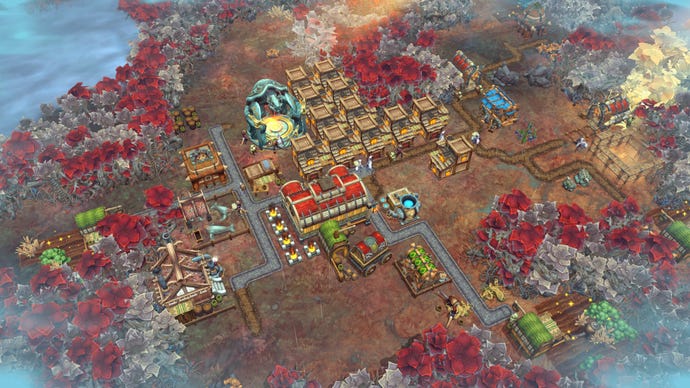
On top of this, the map itself is filled with pockets of mist known as glades. Accessed by ordering your woodcutters to chop through the tangle of trees that surround them, small glades contain an equally measly amount of resources whereas larger expanses contain a bounty of goodies in exchange for a problem that needs to be dealt with: A cemetery filled with restless souls; A totem to a dark god; A camp of bandits, intimidated by your arrival.
These events can only be solved by sacrificing complex and difficult to produce goods, the consequences for failing to meet their demands attached to a timer that must be beaten to avoid losing villagers or gaining a chunk of royal impatience. It is yet another spanner that is thrown into your increasingly jammed works with stressful frequency, forcing you to scrutinise your limited options in an effort to uncover that single golden solution.
It's difficult, but never unfair. As much as Against The Storm throws curveballs at you, it does so knowing full well that there are systems in place to knock them clean out the park. Production lines allow you to swap out base ingredients, rather than forcing you to hunt for a specific thing. Buildings can be moved. Resources can be purchased. Goods can be sold. The pace is breathless, but there is always room to breathe.
The verbs of a roguelike fit so neatly within the structure of a citybuilder that I can’t quite believe it hasn’t been done before. Mechanically there’s nothing here particularly new, but by recontextualising the most basic features of the citybuilding genre through a roguelike lens (Wood is your health! Villagers and buildings are your weapons and power ups! Impatience is your enemy!) everything feels completely refreshed. Even an action as simple as cutting down trees has purpose beyond simple resource gathering here. Doing so allows you to explore and uncover pockets of resources that might help you expand, but might carry greater risk.
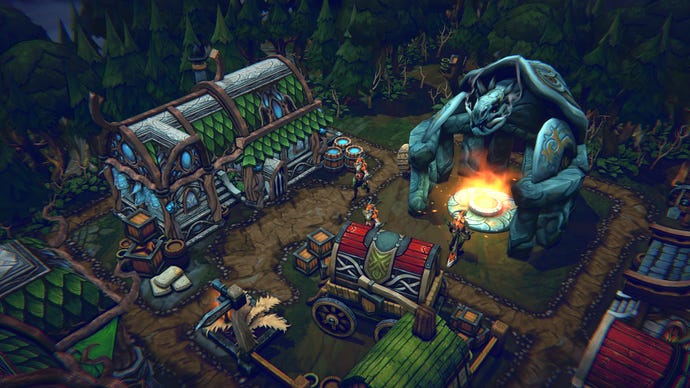
Like any great roguelike, Against The Storm constantly tests your ability to react to a random situation built upon a clearly defined ruleset. If you want to offset the risks and succeed, you have to be aware of all of your options, at all times. How to make biscuits. How to make coats. How to appease an angry ghost. How to repair a malfunctioning machine. Within each settlement there is a story, a sense of drama that escalates and subsides as you desperately try to keep a thousand plates spinning as they are whipped and battered by an ever present storm.
It is so lean and so focused in its execution, that Against The Storm manages to bypass that creeping sense of ennui that is so often associated with the end of a long playthrough of something like - let’s say - Cities Skylines. If, like me, you prefer being offered a list of fixed goals rather than a sandbox designed for expressive creativity, then this is exactly what you’ve been looking for. A management game with an endpoint, one that leans towards the earliest stages of city planning, with each settlement taking no longer than 90 minutes to complete.
Your bitesize builds are all wrapped up in this dark fantasy dressing that drips with dread. Meat is sliced from the decaying carcasses of enormous leeches. Buildings are ramshackle, understandably designed for their function and not longevity. Although your population is made up from different, visually distinct species, they all walk through your settlement with the same familiar hunch, covering themselves from the unrelenting rainfall after a long day toiling in the gloom. The forest itself is palpably sinister. Depending on the biome trees can be blood red, skeletal, knotted like roots or vibrant like coral. The glowing fire of the hearth is the only comforting visual in the entire game. None of it is pleasant, but it adds a sense of grim fatigue to your excursions.
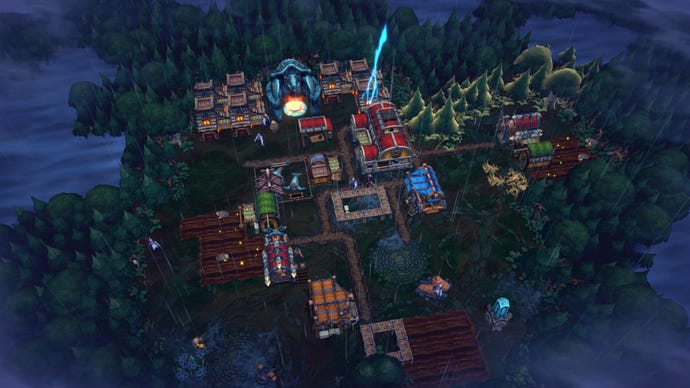
For those who have already sunk countless hours into the game’s early-access version, 1.0 introduces an ultra hard mode designed for veteran viceroys. The Queen’s Hand Trial challenges you to complete the game’s most difficult task (finding - and then gluing - bits of a broken seal back together) within a single storm phase. Failure to do so results in losing all of the upgrade items you acquire during your time with the mode. Personally, I found this a bit too tough to experience in earnest, but it’s nice to know it’s there if I ever manage to reach the point of mastery it's clearly designed to test.
There is - somehow - even more to it than this. Little details like Storm phases, villager preferences, and a skill tree that's abstracted as a lightweight citybuilder in itself. Like most games in its genre, Against The Storm is designed to be returned to time and time again, except here a fresh start is always seen as progress. It makes for a construction game that wraps up at precisely the moment it begins to lose momentum. It is a wonderful, wonderful thing.
Sausages and jam is a silly example, because it’s obvious why they work together so well. Pork and apple sauce is a cornerstone of this island’s cursed cuisine, and what is jam if not another sweet accompaniment. But someone has to be the first to put these things together, right? Someone has to be brave enough to see the reasons why a particular pairing makes such a beautiful pairing. This is exactly the reason why Against The Storm is so exciting. It just makes sense.
This review was based on a review build of the game provided by publishers Hooded Horse.
